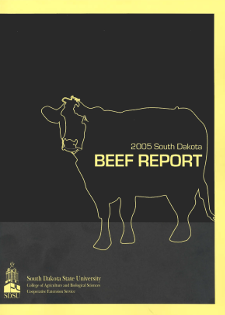Document Type
Report
Report Number
2005-5
Publication Date
2005
Keywords
sulfate, growing steers, calf growth
Summary
Data from our laboratory showed water sulfate levels of 3,000 ppm reduced performance and health of growing steers during summer months. In addition, water averaging 2,600 ppm in sulfates for cow-calf pairs had little impact on calf growth or milk production, but caused small reductions in cow BW and body condition score (BCS). This experiment was conducted to evaluate the effects of high sulfate water on cow and calf performance, milk production, and reproduction. Ninety-six crossbred, lactating cows (ages 2-13; average calving date of April 14) and their calves were assigned, after stratifying by age, weight, and previous winter management, to one of six pastures (16 cows/pasture). Pastures were randomly assigned to one of two water sulfate levels (three pastures/level). Treatments were low sulfate (LS) water (average 368 ± 19 ppm sulfates) or high sulfate (HS) water (average 3,045 ± 223 ppm sulfates). The HS water was created by adding sodium sulfate to the LS water. Cows grazed native range and received a conventional mineral supplement ad-libitum from June 3 to August 26, 2004. Water was provided in aluminum stock tanks. Cow 12-h milk production was estimated by the weigh-suckle-weigh method on August 7. Cows were synchronized with a single injection of prostaglandin and bred by natural service. There were no differences in cow weight or BCS change during the trial (P > 0.15). Twelve-hour milk production in August was higher (P = 0.02) for LS (9.0 lb) than HS (7.5 lb). Calf ADG tended to be higher (P = 0.14) for LS (2.56 lb/d) than HS (2.45 lb/d). The percentage of cows that became pregnant during the first 25 days of the breeding season was higher (P = 0.06) for LS (81%) than HS (64%), and final pregnancy rates (55-d breeding season) were 92% and 83%, respectively (P = 0.20). Sulfate levels averaging 3,045 mg/L in the drinking water of cow-calf pairs during the summer reduced cow milk production and the number of cows bred early in the breeding season.
Number of Pages
4
Format
application/pdf
Language
en
Publisher
South Dakota State University
Rights
Copyright © 2005 South Dakota State University
Recommended Citation
Patterson, Hubert; Johnson, Pat; Perry, George; Gates, Roger; and Haigh, Ron, "Response of Cow-calf Pairs to Water High in Sulfates" (2005). South Dakota Beef Report, 2005. 6.
https://openprairie.sdstate.edu/sd_beefreport_2005/6

